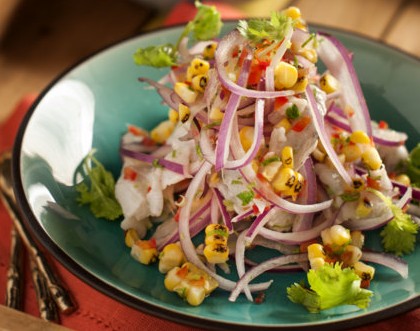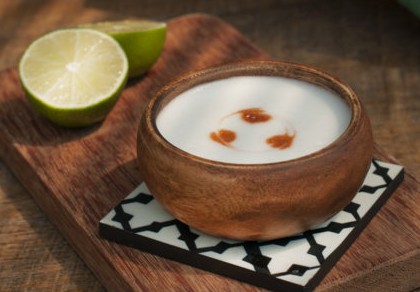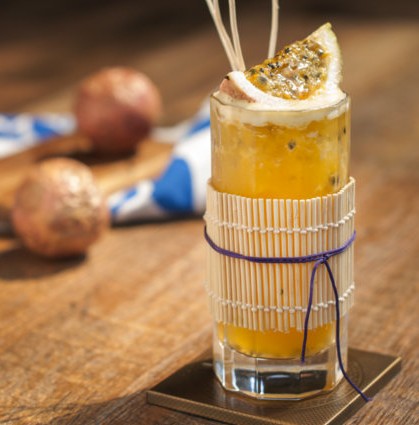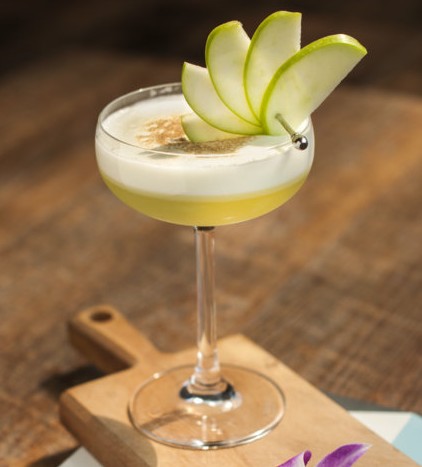Tiger’s Milk, as its name suggests, packs a punch. A loose translation of Leche de Tigre, which is a Peruvian citrus-based marinade used to cure seafood in ceviches, Tiger’s Milk is believed to be both a hangover cure as well as an aphrodisiac in Peru.
Perched atop The Club, with a rooftop view of the Ann Siang Hill district, Tiger’s Milk is clad with a kaleidoscope of colours, including a painting of the great Amazon forest at the stairwell.
We started off with some para picars (small plates). First up was the Tiger’s Milk Trio ($9), which features three shots of seabass and octopus served in increasing order of spiciness: Nikkei (Japanese-Peruvian fusion), Amarillo (Peruvian yellow pepper), Rocoto (Peruvian chilli pepper).
If you aren’t particularly a fan of spice, be sure to stick to Nikkei, a fusion of Japanese and Peruvian cuisine. Blended with shoyu sause, the Nikkei has a subtly sweet and pleasant flavor that is easy on the palate. The Amarillo and Rocoto are the spicier siblings of the Nikkei, and can verge on being acerbic. Spice lovers will enjoy this. If you’re game, request for their house pisco (Campo De Encanto Acholado specially imported from Peru) to be added for that extra punch.
We next had the Causa (S$16), a cold dish of mash potato, shrimps, sliced avocado, chopped hard-boiled eggs and Ají Amarillo. This dish is very popular in Lima, where varieties of meat may be added to the mixture.
Much of the Peruvian cuisine adapted in accordance to its aquatic resources from the Amazon river. The ceviche, a South American dish of marinated raw fish or seafood is believed to be an aphrodisiac and hangover cure, usually with a light spicy flavor.
We had the Classic Seabass Ceviche (S$14) – fresh seabass marinated in citrus, tossed with chopped Ají Rocoto, red onions and grilled corn, and served with sweet potatoes.
While the seabass was decent, the Salmon Nikkei (S$16) deserves a special mention. The dish of thinly sliced salmon with yuzu and ginger dressing and wasabi tobiko, topped with crispy vermicelli was an interesting fusion of South America and Asia. Firstly, the salmon was fresh, while the dressing was lightly spicy without being overly intense. Hints of yuzu and ginger were balanced with a spiced kick from the wasabi tobiko. The crispy vermicelli did its part of enlivening the dish with an Asian touch.
But that was not the star of the show just yet – the anticuchos were.
Anticuchos – translated loosely as “cut stew meat” – is the hallmark of Peruvian cuisine. While anticuchos can be made of any type of meat, beef and lamb hearts (yep, hearts) are popular.
We tried the Lamb Heart (S$16) marinated with Harrisa paste, served with salsa criolla. I had expected the lamb heart to have that rubbery texture of hearts, but it turned out delicious. The lamb heart had the distinct gamey flavour, but with a unique, not-too-chewy texture which brought out its juicy, rich taste with each bite. It was perfectly grilled with a slight burnt flavor, neatly complemented by the slightly spicy marinade. If you’re a carnivore at heart, you will love this.
The Lamb Heart was only rivaled by the Pork Neck and Shishito Peppers (S$18), which were served on skewers, glazed with yakiniku sauce. We loved how the pork neck had a slight smoky taste to it, while it was tender and super-juicy. Japanese influences on this dish were strong, probably due to the fact that Chef Hajime Kasuga has had 20 years of culinary experience in Mediterranean, Japanese and Peruvian cuisine under his belt.

Pisco and Ceviche Bar. Photo courtesy of Tiger’s Milk.
At this point, we were rather satisfied, but what’s a Peruvian meal without some drinks?
Have your pick among their pisco-infused concoctions. Pisco Sour (S$18), Campo De Encanto Acholado, lemon and egg whites shaken and finished with a dash of Amargo Chunco Bitters is one of their house specials, and a hot favourite amongst diners. The Peruvians claim this as their national drink. I thought that it was very well-balanced with the addition of the foamy head (courtesy of the shaken egg white) and not too dry.
For the ladies, or if you’ve a sweet tooth, try the Piscorhinha (S$18) – pisco shaken with calamansi, passionfruit, sour plum topped with champagne, or Pisco Verde (S$20) – Campo de Encanto Acholado Midori Cointreau and apples. Both drinks are bright and refreshing with a fruity finish.
My personal favourite was the Coco Con Pisco (S$24), which tastes closer to a dessert than an alcoholic drink. Campo de Encanto Acholado infused with pandan, Frangelico, Malibu, rock melon and kaya, shaken and served in a coconut! Scrape the insides of the husk for that added coconut meatiness.
From delicious bites to specialty concoctions, Tiger’s Milk is a hidden gem at Ann Siang Road, where you be spirited away to Peru by its unique charm.
Tiger’s Milk Rooftop Bar & Grill
28 Ann Siang Road
Singapore 069708
Opening Hours: Mon to Thu – 5pm to 1am; Fri to Sat – 5pm to 2am; Closed on Sundays













![[REVIEW] 1-Group Switches Out Au Balcon for il Giardino at the Singapore Botanic Gardens](https://asia361.com/wp-content/uploads/2025/07/IMG_2036-214x140.jpg)
